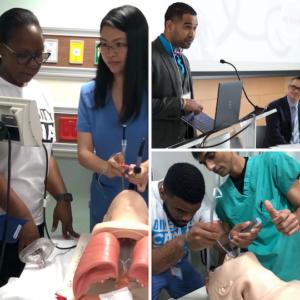
In 2003, as a nurse anesthesia student at La Salle University, Wallena Gould, EdD, CRNA, FAAN, immediately noticed the lack of diversity in her program. At the time, all six Philadelphia-area nurse anesthesia programs had a shared curriculum, which meant Gould was in large classrooms with different cohorts of students. She was one of the few nurse anesthesia students of color in the room.
“All of the nurse anesthesia faculty in the different nurse anesthesia programs were all white. There were no full-time CRNA faculty of color, and maybe only three or four students of color,” she said. “I wanted to find out what the diversity makeup of the profession was.”
She had an assignment to do a poster project on any topic in nurse anesthesia. Gould decided to address diversity in nurse anesthesia. She compared the racial and ethnic composition of the Philadelphia-area programs with that of CRNAs nationally. The data mirrored each other, Gould said, and showed the lack of diversity within the profession.
Through the encouragement of her then-program director, Arthur Zwerling, CRNA, MSN, MS, DNP, DAAPM, Gould attended her first AANA meeting—and met a legend in the field of nurse anesthesia, Goldie Brangman, MEd, MBA, CRNA, the first and so far the only Black president of the AANA.
“I had already been in my program for over a year, and no one had mentioned her name at all, so I didn’t even know that she existed,” Gould said. “To see a Black woman as a past president of the AANA blew me away.”
Several years later, Gould continued to mentor nurses of color interested in nurse anesthesia in the northeastern U.S. In 2008, she invited Brangman to speak at a diversity information session in New Jersey at her church home. Brangman spoke about her experience as the program director at the Harlem Hospital nurse anesthesia program, and the discrimination she faced during the Jim Crow era. She encouraged students to pursue doctorate degrees and serve on their state association’s boards or the AANA board of directors.
From that meeting, five of the students became president of their state associations, and four went on to earn PhDs and a doctorate in education.
“It was pretty remarkable just to be in her presence. The way she talked to everybody, we took it to heart. She was phenomenal,” Gould said.
AANA senior leadership also came to speak to students about advocacy and issues facing the profession. More presentations, simulation labs, and information sessions followed in other areas of the country. What started as a poster project led Gould to create the Diversity in Nurse Anesthesia Mentorship Program (DNAMP), whose mission is “to inform, empower, and mentor under-served diverse populations with information to prepare them for a successful career in nurse anesthesia.”

Most of the students who attend the DNAMP’s events are first-generation college students who need a trusted source of information, Gould said. Students receive not just information, but hands-on experience and networking opportunities to help empower them as they apply to nurse anesthesia programs.
Gould recently authored an article in the journal Teaching and Learning in Nursing about the DNAMP program initiatives and the impact of the program. The article looks at the “historical context of disparities within the nurse anesthesia workforce and discusses how the DNAMP model can be used to combat it.”
Thanks to the DNAMP, 614 students (including recent May 2021 graduates from nurse anesthesia programs) from historically excluded and underrepresented populations have become CRNAs. Here are three of those students’ stories:
Feeling Truly Supported and Heard
Amazing-Grace Ighedo, SRNA, BSN, RN, BA, CCRN, a student registered nurse anesthetist at the University of Pennsylvania, is one of the students who decided to become a CRNA thanks to the DNAMP. She learned about the program through an article in Minority Nurse Magazine that discussed mentorship and the path to becoming a CRNA for persons of color. Later, after she wrote an essay that won the magazine’s scholarship contest, she connected with Gould and attended a DNAMP event.
“DNAMP not only prepares you for interviews and how to write your essays, it prepares you mentally. You see others who look like you share their stories and struggles, you make incredible lifelong friendships, you get tips on how to financially prepare as a family for this long and arduous journey … I could go on and on,” she said. “This program has definitely equipped me and led me to choose a program in which I feel truly supported and heard.”
She said as a program focused on mentorship for persons of color, DNAMP helps with overall preparation for success in anesthesia school. “It is motivational given the history of the profession seeing how far it has come with CRNAs of color. Joining DNAMP provides that community of mentorship support. You are never and will never feel alone in your journey to becoming a CRNA.”
Providing a Blueprint for Success
Steffen Lewis, SRNA, BSN, RN, CCRN-CMC-CSC, is a student at the University of Arkansas for Medical Sciences who has also benefitted from the DNAMP. He said as a senior nursing student, he unexpectedly became a father and found the pursuit of nurse anesthesia school daunting.
“The DNAMP became a backbone for my personal and professional growth, providing a blueprint for success through inspirational, relatable, and influential connections with its members,” he said.
“In addition, the DNAMP has challenged me to become more than just an anesthesia provider but has developed my passion for advocacy, mentorship and has also strengthened my community service efforts.”
He added that the DNAMP is not just for nurse anesthesia school applicants. “This professional network can provide lifelong professional mentorship and support while also providing the opportunity to get involved and mentor the next generation of future CRNAs.”

Giving Back and Paying It Forward
Howard Booth, SRNA, a student at Loma Linda University, was working as a bedside nurse in the intensive care unit when he heard about the DNAMP from an SRNA friend. After attending his first event, he began volunteering with the program.
“I believe strongly in mentorship, giving back, and helping others. Those were core values central to my upbringing. The DNAMP has provided me a vehicle through which I can channel my living out those beliefs,” he said. “Being involved with the DNAMP gives me consistent exposure to like-minded individuals who sincerely want to help others and diversify the many faces that comprise the anesthesia workforce.”
To students considering the DNAMP, he said, “Don’t wait! The more you wait to get involved, the higher your regret for not getting involved sooner. Accelerate the pathway to your discovery of the anesthesia profession so that you either save time by coming to the realization that the profession isn’t something you want to pursue, or you realize that you are passionate about the profession and sooner optimize your pathways to getting into the profession.”
Booth also stressed the importance of paying it forward.
“Strive to help someone else in a position in which you used to be. Never forget what it was like. Always strive to be a better preceptor to a student than all the preceptors you had. Strive to be a better colleague to others than the colleagues with whom you’ve worked. Just keep raising the bar by paying it forward,” he said.